3 Design the Study and Develop a Data Collection Plan
At this stage, relevant data is collected to test the hypothesis and answer your research question. There are many ways to do it. Plan and decide how you will collect your data.
Learning Objectives
After completing this chapter, you will be able to:
- explore different types of research studies and their key features, advantages, and limitations
- develop a comprehensive data collection plan by applying the 5W1H approach (Why, Who, What, When, Where, and How)
There are various types of research that you can conduct according to the sources of information, type of data used, and research purposes. It’s important to note that a research project will not be limited to one type of research, but will likely use several. Understanding the types of research and what each of them focuses on will allow you to better plan your project and utilizes the most appropriate methodologies and techniques. It is also important to know the advantages and limitations of each type of research to avoid misinterpretation of the research output and better communicate your findings to other researchers.
Sources of Information: Primary vs Secondary Research
Research can be divided into two groups based on how the data is collected: primary and secondary. Primary research is when you collect the data yourself while secondary research is when you use existing data to do your research. Primary research can be executed through observations, experiments, surveys, interviews, and other approaches. The main advantage of primary research is that you may set up and use a data collection strategy that is tailored to your study objectives. On the other hand, you can retrieve and synthesize secondary data from a variety of sources, such as scholarly journals, databases, and even museum collections. However, you have no control over how the data was collected firsthand.
Check Point 3.1
BOX 3.1: Examples of primary and secondary research
Lets explore how a researcher can study the biodiversity of a specific group of beetles in a particular region using primary and secondary research.
Primary research provides first-hand and customized data that can be conducted by the following approaches:
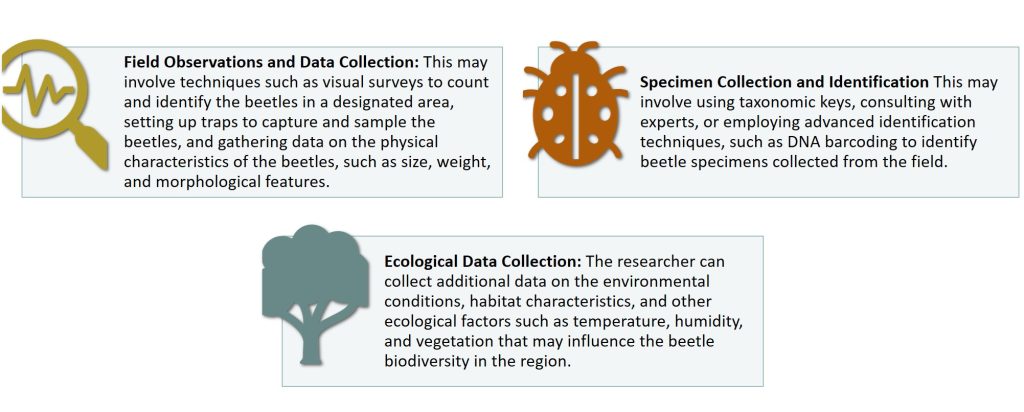
Secondary research leverages existing information and can include the following approaches:
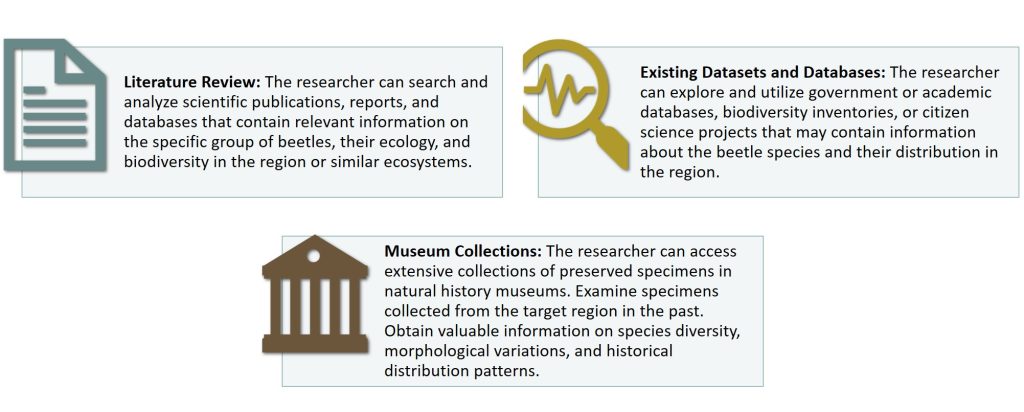
By combining the primary research approach, which involves direct field observations and data collection, with the secondary research approach, which utilizes existing literature and data sources, the researcher can gain a more comprehensive understanding of the biodiversity of the specific group of beetles in the particular region. The integration of these two approaches can lead to more robust and reliable research findings.
Type of Data Used: Qualitative vs Quantitative
Qualitative and quantitative research uses different types of data for research purposes. Qualitative research gathers non-numerical data to investigate subjective experiences, perceptions, and behaviors, whereas quantitative research collects numerical data to quantify and measure specific aspects of the research topic.
Watch this video to learn about qualitative and quantitative research [1 min, 08 sec]
“Quantitative & Qualitative Research” by KU Libraries is licensed under CC BY-NC-SA 4.0
Lets explore how a researcher can study the impact of mining activity on fish biodiversity via qualitative and quantitative approach.
Qualitative research can include the following approaches:
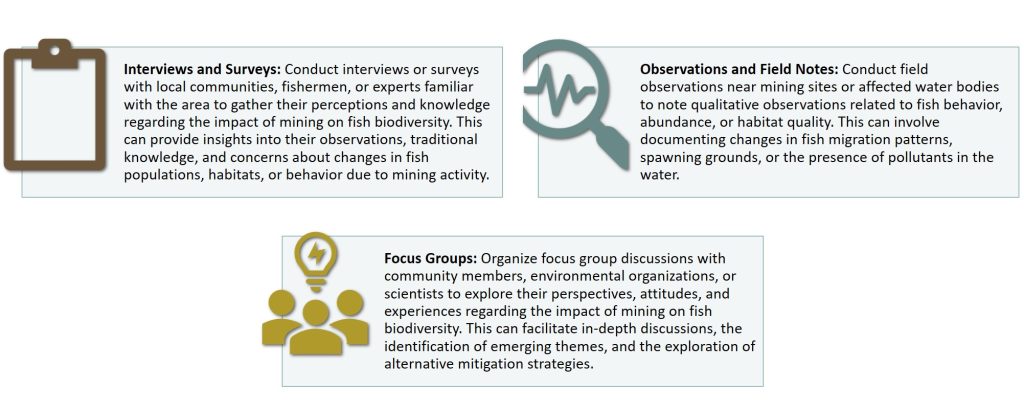
Quantitative research can include the following approaches:
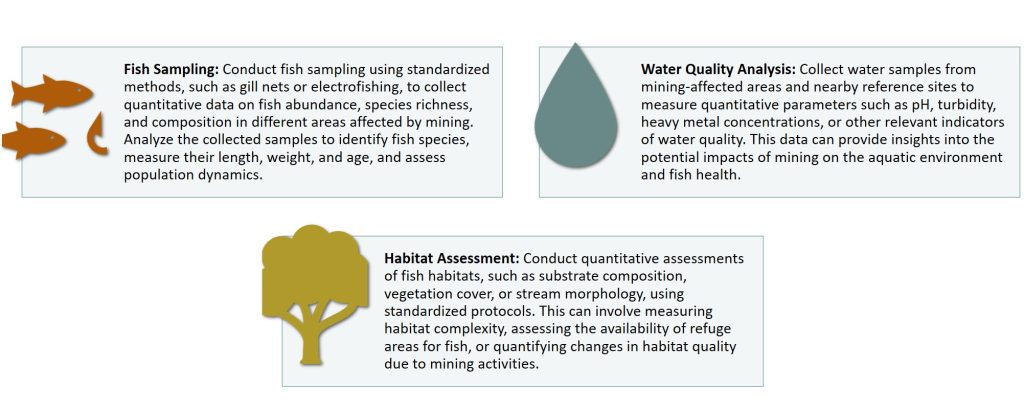
By combining qualitative and quantitative research methods, researchers can gain a comprehensive understanding of the impact of mining activity on fish biodiversity. Qualitative data provide insights into local knowledge, perceptions, and the human dimension of the issue, while quantitative data provide objective measurements and statistical evidence of changes in fish populations, habitats, or water quality. The integration of both types of research supports a more holistic understanding of the complex relationships between mining activity and fish biodiversity, guiding conservation efforts and informing sustainable resource management practices.
Research Purposes: Exploratory, Descriptive, Correlational, and Explanatory Research
Exploratory research is conducted when a topic was previously unexplored or poorly understood, and the purpose is to explore the nature of the phenomenon. This type of research is often initiated to obtain preliminary insights. Sometimes referred to as hypothesis-free research, exploratory research involves developing hypotheses and identifying key variables. After basic insights and concepts have been obtained, descriptive research is useful to provide a more detailed understanding. The focus is on documenting and describing the characteristics, patterns, and interactions of the variables.
Compared to exploratory and descriptive research, correlational and explanatory research typically require a more substantial foundation of prior research. While correlational research investigates relationships between variables without necessarily showing causality, explanatory research looks at the underlying mechanisms and causal links. A correlational research measures the variables exactly as they are, and examines the direction and strength of correlations between variables. On the other hand, explanatory research uses controlled experiments, manipulation studies, or longitudinal investigations to figure out why and how certain phenomena happen.
Let us focus on the study of the plant-pollinator system in the grassland ecosystem, and explore how to conduct the study with different research purposes.
Exploratory Research:
The goal of exploratory research is usually to identify relevant variables, generate initial hypotheses, and refine the research question for the next stage of the study.

Descriptive Research:
The goal of descriptive research is to provide a comprehensive and accurate description of the current state of the plant-pollinator system in the study area. This could involve the following approach:

Correlational Research:
The goal of correlational research is to understand the degree to which changes in plant abundance are associated with changes in pollinator diversity, without necessarily establishing causality.

Explanatory Research:
The goal of explanatory research is to find and explain the primary causes of the observed patterns in the plant-pollinator system.
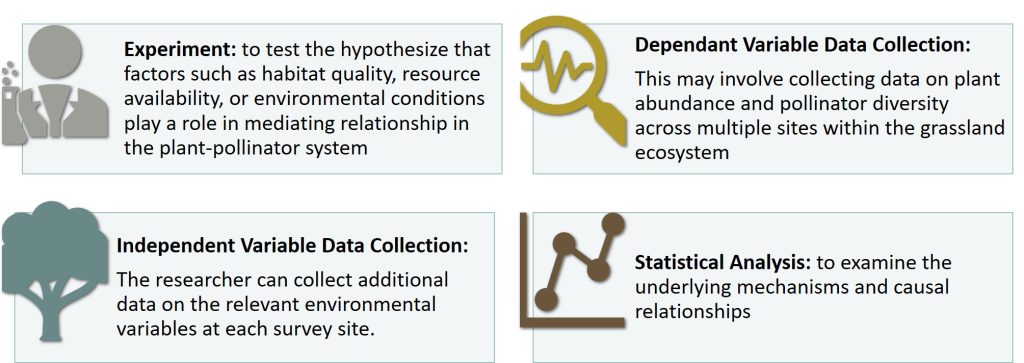
Through a combination of exploratory, descriptive, correlational, and explanatory studies, the researcher can develop a thorough understanding of the plant-pollinator system in the grassland ecosystem. The process begins with an exploratory phase that helps to refine the research question, continues with the collection of baseline data to uncover patterns, and ends with discovering significant relationships, and underlying mechanisms between the key variables of interest.
Keep in mind that the type of study design you choose will rely on your specific research goals and study objectives, the resources you have at your disposal, the nature of the research question, and the current state of knowledge in the field. You are free to use more than one of these research designs in a single study to develop a deeper comprehension of the research problem. Click on the drop-downs to read more on the summary of key features, advantages, and limitations of different research types, and select the most suitable one for your research.
Data collection is one of the most resource-intensive tasks in the research process, where time, money, and labor are invested. Thus, developing a thorough data collection plan is critical to ensure the process is smooth and maximizes the quality and reliability of the collected data. You can improve your data collection strategy by taking into account the essential elements of the 5W1H approach, which are the Why, Who, What, When, Where, and How. Here’s a step-by-step guide for each component:
Why?
When designing a data collection plan, you should be clear about the aim of your data collection. Determine why you require this data and why you are collecting it in this way. It allows you to collect the right sample in the right way. Justify the acceptability of your selected methods with a detailed explanation. The most common practice is to use prior studies that have successfully employed a similar method to collect relevant data or to adhere to established protocols and standard methods. The ultimate goal of data collection is to gather evidence to test hypotheses and answer research questions. Make sure the method you have chosen will provide valid and reliable data that aligns with the research questions, hypotheses, and objectives.
BOX 3.4: Examples of WHY component in the data collection plan
You should provide a justification for your choice when defending the use of a selected method for data collection. Let us use the example of qualitative and quantitative research in BOX 3.2 to explore some points to help justify the acceptability of a data collection method:
| WHY component | Things to be considered |
| Testing hypotheses or research questions | Clearly explain whether the data obtained is relevant and can be used to address the particular goals or research questions. For example, information directly collected from individuals affected by mining activities through surveys and interviews allows us to gather their perceptions and knowledge regarding the impact of mining on fish biodiversity which aids in answering research questions concerning the specific consequences on fish biodiversity and related factors. |
| Quantitative methods, such as fish sampling combined with water quality analysis and habitat assessment, can provide data to test the hypothesis that there are significant relationships between mining activities, water quality parameters like pH, dissolved oxygen, turbidity, and nutrient levels, and their effects on fish populations. | |
| Validity and Reliability | Justify your selected method by demonstrating its validity and dependability. For instance, validated survey instruments and rigorous interviewing techniques are used to increase the credibility of the acquired data. |
| Standardized protocols and established standard methods for fish sampling, water quality analysis, and habitat assessment can justify the acceptability of the chosen methods. | |
| Ethical considerations | Informed consent from participants is obtained before conducting surveys, interviews, or focus group discussions to address ethical considerations associated with the data collection. |
| Field observations and sample collection are conducted in a way to minimize disturbance to the environment and adhering to relevant regulations and permits. For example, fish sampling and handling are conducted in a way to minimize stress and ensure the well-being of captured individuals. |
Eventually, choose a strategy that is practical given the available resources, including time, budget, personnel, and equipment. Explain why the method is the most practical and efficient way to collect the necessary data within the given limits.
Who?
Conducting research, particularly postgraduate studies, is a solitary endeavor. You will need a lot of self-commitment and self-discipline to continue and succeed on this journey. However, research is not a one-man show either. Throughout the research process particularly during data collection phase, you will interact with lots of people either directly or indirectly, regardless of whether you are working on surveys, questionnaires, field samplings, or lab experiments. It could involve the research participants, field assistants, institutional staff, ethical review board, and government agencies. Identifying the WHO involved in your data collection plan is critical for you to successfully conduct your research.
BOX 3.5: Examples of WHO component in the data collection plan
Let us use the example of qualitative and quantitative research in BOX 3.2 to explore who you’ll be dealing with during the data collection process, assuming you are the one who plans to study the impact of mining activity on fish biodiversity.
The list below are points that you might take into considerations for the qualitative research.
| WHO component | Things to be considered |
| Government agency / Ethical review board | Obtaining research permission is a prerequisite for sample collection. Identify which agency grants permission for the research. |
| Identify the ethical review board or committee that is responsible for reviewing and approving the ethical aspects of qualitative research. | |
| Research participants | Identify the right participants, such as local community, fisherman, environmental organization, and scientists that are familiar with the area. Ensure their cooperation and consider the ethical aspects, such as obtaining informed consent, ensuring participant confidentiality, and complying with relevant regulations. |
| Field researcher/ Field assistant | Sometimes language could be an issue when conducting qualitative research, like an interview. Is a translator required to assist you during the interview session with the local communities? |
On the other hand, the list below illustrates the WHO component when you are conducting quantitative research.
| WHO component | Things to be considered |
| Government agency / Ethical review board | Obtaining research permission is a prerequisite for sample collection. Identify which agency grants permission for the research. |
| Identify the ethical review board or committee that is responsible for reviewing and approving the animal ethics since fish is the study subject. | |
| Field researcher/ Field assistant | Some sampling procedures may be conducted by a single person, while others may necessitate additional personnel. Do you need field assistant(s) to help you with the habitat assessment, fish sample collection, and water sample collection? Is a porter required to assist in carrying the heavy apparatus to the sampling site? |
| Some sampling sites may be difficult or inaccessible. Is a local guide required to bring you to the remote sampling area? | |
| Institutional staff
|
Some laboratory procedures might require specialized instruments. Do you need a lab assistant to operate the instruments? Do you know who is the staff handling the reservation of the lab that you are working at? Have you check who to call in case of an emergency in the lab? |
| Laboratory analysis requires chemicals, tools, and consumables. Who is the staff or supplier that can provide the materials that you need for the lab analysis? |
The checklist above illustrates the persons that might be involved directly or indirectly during the data collection. Identify each of them along with their contact information, such as phone number or email address, when you develop your data collection plan to ensure smooth operation.
What?
Conducting research requires a bunch of tools and materials. The tools and materials required for research vary depending on the nature of the study, the research field, and specific research objectives. List out as much detail as possible of what you need for your research, including consumables, field equipment, laboratory equipment, specialized instruments, and even software for subsequent data analysis. In addition, safety equipment such as additional personal protective equipment (PPE) depending on the specific sampling activities, lab work, and potential hazards should not be overlooked as well.
BOX 3.6: Examples of WHAT component in the data collection plan
These are a few examples of the tools and materials you will need for your research. The list of items is not yet exhaustive.
| WHAT component | Things to be considered |
| Consumables | Notebooks, pens, and markers for taking observation notes, recording data, and labeling collected samples. |
| Paper, printing supplies, and stationery for printing questionnaires, consent forms, or other documents. | |
| Storage containers or plastic bags for fish and water sample collection or storage. | |
| Disposable gloves, masks, wipes, and other cleaning supplies for maintaining hygiene during fieldwork and lab work. | |
| Field equipment | GPS devices for recording locations. |
| Surveys, questionnaires, or interview guides for collecting data from participants. Digital voice recorders or video cameras for recording interviews or observations. | |
| Sampling equipment such as fish nets or electrofishing device to catch fish samples, a pail to collect water samples, a multiparameter water quality sonde to record in-situ water quality parameters | |
| Laboratory equipment | Microscopes, centrifuges, autoclave, water bath, oven, spectrophotometers, pipettes, test tubes, beakers, flasks, petri dishes, and so on for sample processing and analysis. |
| Specialized instruments | Atomic absorption spectroscopy (AAS) or inductively coupled plasma mass spectrometry (ICP-MS) for determination of heavy metals. |
| Software and computing | Statistical analysis software such as SPSS for data processing and analysis. |
| Spreadsheet software such as Microsoft Excel for organizing and managing data. | |
| Qualitative data analysis software such as NVivo for coding and analyzing qualitative data. | |
| Safety equipment | First aid kit and additional personal protective equipment (PPE) depending on the specific sampling activities, lab works, and potential hazards. |
| Determine the suitable attire such as wading boots or water shoes during water and fish samplings in streams; or safety goggles, lab coats or protective clothing for lab work. |
Try to be as thorough as you can when listing the things you require. Checks inventories regularly during the data collection process. This is to ensure that you have an adequate supply of the necessary consumables and essential instruments for your research to avoid disruptions or delays in work.
When?
Conducting research requires good time-management skills. Planning ahead and keep organized for your research activities. It’s also crucial to be proactive and flexible in how you manage your research schedule. Always have a plan B that accounts for potential contingencies, delays, or unforeseen circumstances. A detailed list of research activities, milestones, and a Gantt chart are important for developing a data collection plan and for subsequent progress monitoring.
BOX 3.7: Examples of WHEN component in the data collection plan
Here are some key aspects to consider when planning your research activities.
| WHEN component | Things to be considered |
| Fieldwork | Identify the optimal sampling times and conditions for your fieldwork. Plan ahead for the appropriate season, weather conditions, or ecological phenomena that address to your research question and hypotheses. |
| Plan ahead for scheduling participant appointments, taking into account their availability and any specific requirements for data collection. | |
| Develop a detailed timeline for your sampling activities, estimate the duration required for each task or appointment. Conduct a recce or a pilot study for a better estimation. | |
| Lab or Facility Bookings | Determine the availability of lab, facility or any resources you may need. Booking in advance and ensure they are available during your scheduled time slots. |
| Administrative Tasks | Allocate time for administrative tasks such as preparing consent forms, ethics and research permit applications, or processing reimbursement for the expenses spend during research. |
| Initiate the application process early, check any deadlines for submission, and ensure you have sufficient time to complete these tasks. |
Ensure prompt and transparent communication with the individuals you identified in the WHO component. Send reminders closer to the appointment dates to confirm appointments and ensure everyone is aware of the scheduled dates to minimize no-shows or scheduling issues.
Where?
Identify the physical or virtual locations where data collection will take place. This could include study area, specific sites, institutions, or online platforms. The study area, which can be a particular habitat, region, or community, is the geographic area on which the research is largely focused. It could be a forest, a marine reserve, an urban neighborhood, and so on. Your research may cover a small or large geographic area, depending on whether the issue is being posed on a local, regional, or global scale. Field sites refer to locations within the study area where data collection activities are carried out. For instance, a researcher studying tropical biodiversity would collect data from multiple field sites within a tropical country’s national park. Your data collection plan should include not just the study area and field sites where sampling will take place, but also where you will stay if you are doing overnight fieldwork, the location for lab analysis, sample storage, and other activities. Find out where all of the materials and equipment are kept after you’ve made a list of what you’ll need for your research.
BOX 3.8: Examples of WHERE component in the data collection plan
Here are some key aspects to consider when developing the data collection plan for the study of the impacts of mining activities on fish biodiversity.
| WHERE component | Things to be considered |
| Study area | The study area would be the specific geographical region where the mining activity and fish biodiversity are of interest. This could be a particular watershed, river system, or a defined area impacted by mining activities. |
| Field site | Identify the field sites within the study area for surveys and interviews, such as villages located in the vicinity of the mining activities. |
| Determine appropriate locations for conducting focus group discussions. These can be community centers or meeting rooms where participants can gather and engage in group discussions about the impacts of mining on fish biodiversity. | |
| Select the specific sites within the study area where fish sampling, water sample collection, and habitat assessment will take place. These sites should cover a range of habitats, proximity to mining sites, upstream and downstream locations, and areas affected by runoff or discharge to represent different levels of exposure to mining activities. Selecting field sites for sample collection should also take accessibility and safety into mind. | |
| Facilities / Resources whereabouts | Locate any facilities or resources you will need for your research, such as the lab you may use for water quality analysis and fish sample processing, and make sure you have access to them. The instruments you require for the analysis could be located in a different lab or building. Sometimes, the facilities can be located outside your research institution, for example, those that provide specific analytical services. |
| Online platform | Data collection can also take place in virtual spaces through web-based surveys, online interviews, or online focus groups. This allow researchers to collect data remotely and reach a broader audience. |
The selection of study areas and specific sites should be based on a combination of scientific considerations, logistical feasibility, and relevance to the research questions and objectives. Additionally, ensure that all necessary permissions and permits are obtained before conducting data collection activities in the selected sites.
How?
Before initiating data collection, get proper training and acquaint yourself with the procedures, instruments, and techniques. This includes interview tactics, sampling procedures, laboratory analyses, and so forth. Make sure you understand how to use the equipment or tools safely. If you are working with a team, make sure that everyone understands their roles and responsibilities during the data collection process. Creating flow charts or step-by-step procedures will help to ensure that data is collected efficiently and accurately.
BOX 3.9: Examples of HOW component in the data collection plan
Here are some important points to keep in mind:
| HOW component | Things to be considered |
| Fieldwork | How are the fieldwork preparations made? Have you planned transportation to the study area or accommodations if the fieldwork is overnight? Have you packed all of the necessary equipment and tools for the field? Have you confirmed that all of the tools and equipment are in good working condition prior to departure? |
| For qualitative research, determine how you will conduct focus group discussions, surveys and interviews. Ensure you understand the principles of effective interviewing, active listening, and non-verbal communication. | |
| For research involves sampling, determine the appropriate sampling strategy (probability or non-probability sampling) and clearly define the target population and sample size. | |
| If your data collection requires specific equipment or tools, ensure that you are familiar with their operation. Have you read the instruction manuals and practice using the equipment? . | |
| Lab analysis | If laboratory analysis is involved, familiarize yourself with the specific protocols and equipment required. Prepare a step-by step protocol for analytical procedures such as for water quality analysis. |
| Unused samples or samples that cannot be processed in time should be properly preserved, labeled, and stored for future use or reference. Determine the proper preservation and storage guidelines according to the sample type. This could include refrigeration, freezing, or employing specific preservation procedures. For example, acidification, or lowering the water pH to less than 2, is often used to preserve water samples for nutrient analysis, whereas fish samples can be preserved through formalin fixation and ethanol preservation. | |
| Dispose of any unused or remaining chemicals and reagents properly after analysis is critical for safety and environmental compliance. Follow local legislation, guidelines, and best practices when disposing of chemicals. Throughout the handling, storage, and disposal processes, prioritize safety measures to protect yourself, others, and the environment. | |
| Data management and analysis | Define how the collected data will be managed, stored, and analyzed. Establish protocols for data entry, quality control, and data security. |
Before you initiate full-scale data collection, run a pilot test to validate your data collection strategy. Test the tools, procedures, and logistics on a smaller sample size to discover potential issues or possibilities for improvement.
Exercises 3.1
Decide the type of research you plan to conduct and develop your data collection plan with the 5W1H component.
Original research conducted by the researcher or research team to gather new data or information firsthand. It involves collecting data directly from sources such as surveys, interviews, experiments, or observations.
Research based on existing data or information that has been collected and published by others. It involves analyzing and synthesizing data from sources such as books, articles, reports, databases, or previously conducted studies.
Research that focuses on exploring and understanding phenomena through non-numerical data, such as interviews, observations, or case studies.
Research that focuses on collecting and analyzing numerical data to draw conclusions and make predictions.
A type of research conducted at the initial stage of a study or investigation to explore and gain a better understanding of a topic, phenomenon, or problem. Exploratory research aims to generate ideas, hypotheses, or initial insights and often involves qualitative methods like interviews or focus groups.
Research that aims to describe or depict a phenomenon, event, group, or situation as it naturally occurs. Descriptive research focuses on providing an accurate and detailed portrayal of the subject under investigation, often using qualitative or quantitative methods.
Research that examines the relationship or association between two or more variables without establishing causality. Correlational research assesses the degree and direction of the relationship using statistical techniques, such as correlation coefficients.
Research that seeks to establish causal relationships, understand cause-and-effect dynamics, and provide explanations for observed phenomena. Explanatory research often involves quantitative methods and statistical analysis to identify relationships and test hypotheses.

